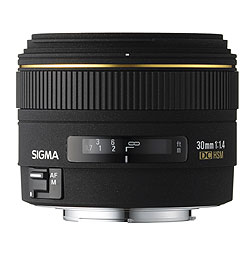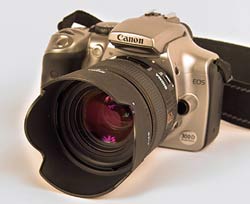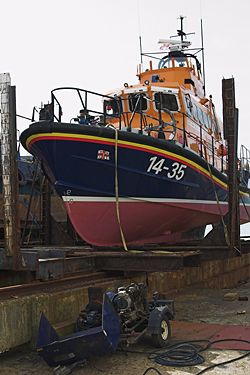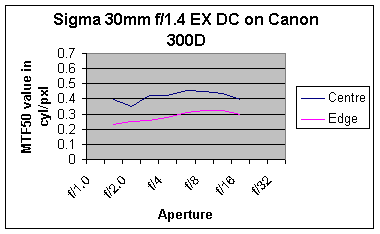Sigma 30mm f/1.4 EX DC
 Sigma, who have grabbed the opportunity of the digital revolution with both hands, need to be congratulated on this one! As we write, it is the only prime standard lens designed exclusively for digital. And it’s a fast one to boot!
Sigma, who have grabbed the opportunity of the digital revolution with both hands, need to be congratulated on this one! As we write, it is the only prime standard lens designed exclusively for digital. And it’s a fast one to boot!
ePHOTOzine is the first UK magazine/web site to get their hands on this new lens and provide a review. Here we take a look at how this totally new lens behaves.
Specification
Focal Length 30mm
Max Aperture f/1.4
Min Aperture f/16
No of Blades 8
Angle of view 45º
Filter size 62mm
Construction 7/7 elements/groups
Focus type AF/MF
Closest focus 400mm (1:10.4)
Weight 430g
Dimensions 76.6x59mm
Mounts available Sigma SA, Canon, Nikon (D),
Tripod bush No
Price (SRP) £320
 Build and handling
Build and handling
As an EX lens, the finish is the same matt black, hard-wearing surface as the remainder of the EX series lenses and comes supplied in the zipped stiff pouch along with lens and mount caps and a petal shaped ‘perfect’ hood. As with all the newer small pouches, it is fitted with a belt loop, making it a useful accessory. The hood is finished to match the lens.
Controls on the lens are simple, consisting of a switch on the left side for AF/MF (except Nikon) and a focus ring. Between the body and the focus ring is a distance window, but, surprisingly, no depth-of-field scale.
The focus ring is well torqued and there is no difference in this torque whichever mode it is used in. The HSM motor, which is both quiet and responsive, allows manual override of the focus in AF mode. As for how responsive, the autofocus was almost instant and as quiet as any lens I have used.
The size and weight of the lens is not unpleasant although smaller primes do exist. The inclusion of the HSM motor probably accounts for this and is well worth the small penalty. The EX build quality seems to improve with every new model, and this latest addition certainly fits that trend.
Optical performance
We all know that primes are better than zooms, don’t we? But with the improved performance of modern zooms, is the price of a prime still warranted? The answer, in the case of this lens, at least, is an emphatic yes! The main reason for this is a lack of compromise. The lens is designed to do one job and one job alone. It does so far better than any zoom can hope to do. The simple construction, just seven elements in seven groups including one Aspherical element, one SLD (special low dispersion) and one ELD (extraordinary low dispersion) element, allows for the best possible corrections. The fall-off in image quality at either end of the aperture range and from the centre to the edge is so much less than any zoom and the light gathering ability is way beyond a zoom’s capability.
The lens has been optimised to work at a single focal length and it has been done well. CA (Chromatic aberration) has been eliminated to all intent and purpose. Shooting against a clear sky and blowing up to 400% showed no evidence of any fringing from f/2 onwards. Contrast is good and colour balance excellent. Only slightly softer at f/1.4, the lens was still usable at this extreme aperture.
With modern, high ISO digital cameras, this lens is the one for shots of the proverbial ‘Black Cat in a Coal Cellar’!
 |  |
 | Ramsgate Lifeboat in for a service. Shot against a plain sky at f/8 and there is no evidence of any fringing. Another studio shot taken at f/11 .A still life of shells taken at f/5. |
 |
Below is our lens test data. To find out how to use this graph look at this article: How we test lenses

Verdict
This is a ‘standard’ lens for a cropped digital SLR. 25 years ago, all SLR’s came with a ‘standard’ lens and everybody learned how to use one. Those lenses, at 50mm, are still about but don’t have the versatility that they had on a 35mm film camera. This 30mm offering from Sigma is a brave move forward that takes a backward step! It makes a lot of sense. The picture quality alone, putting all the acquired knowledge of digital capture from the last few years into a simply constructed lens will pay dividends for those of you who purchase this lens. Me? I don’t really want to send it back!
In summary the main positive points of the Sigma 30mm f/1.4 EX DC are:
![]() Fast aperture
Fast aperture
![]() Picture quality
Picture quality
![]() Consistent performance
Consistent performance
![]() Fast autofocus
Fast autofocus
Negative points are:
![]() Price (Discounted in site shop)
Price (Discounted in site shop)
Check the latest price of the Sigma 30mm f/1.4 EX DC here
Test by Ian Andrews www.wildaboutkent.co.uk
Maybe it's just me but there seem to be a lot of screwy results on this website.
Amazing that some of you compare this lens to zoom lenses. It outperforms any of the Nikkor zoom lenses I have by far. The sharpness in the center is just as good as the “old fashioned standard” Nikkor 1.8/50 I used on F5. Like that lens, this 1.4/30 is much better than any of the zooms in the corners, both on resolution and chromatic aberration. Also there is very little distortion, which is visible only when you make photos of long straight lines like in architecture.
There is only a small problem with auto focus in the worst of lighting conditions, but manual focus under those circumstances work better anyway.
Anyway, just wanted to throw that in. I didn't think the HSM focussing on a D40 was anything special either, and ended up manual focussing in many cases.
Cheers.
Focus on my 40D was fast, but also noticed a fair number of "misses." Guessing that Sigma QC is not very good.
Returned the lens and will be looking at a Canon 28 1.8 or 35 2.
Add your message
Please login here or if you've not registered, you can register here. Registering is safe, quick and free.
photodo Stats
428 MTF tests
74 in-depth photodo reviews
100+ users join each day
Help the lens community by reviewing or rating a lens today via our lens search
Latest Lens Reviews
- Chinon 28mm f/2.8 Vintage Lens Review
- Canon EF 70-200mm f/4L IS II USM Lens Review
- Samyang AF 85mm f/1.4 EF Review
- Sigma 70mm f/2.8 DG Macro Art Review
- Samyang AF 24mm f/2.8 FE Review
- Meike 50mm f/1.7 Review
- Tamron 70-210mm f/4 Di VC USD Review
- Lensbaby Burnside 35mm f/2.8 Review
- Asahi Super Takumar 50mm f/1.4 Review
- Asahi Super-Multi-Coated Takumar 135mm f/3.5 Review

